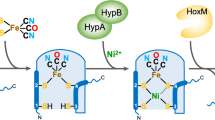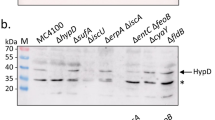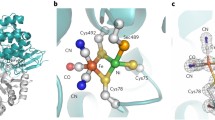Abstract
The biosynthesis of the dinuclear metal cluster at the active sites of the [NiFe]-hydrogenase enzymes is a multi-step process executed by a suite of accessory proteins. Nickel insertion during maturation of Escherichia coli [NiFe]-hydrogenase 3 is achieved by the metallochaperones HypA, SlyD and the GTPase HypB, but how these proteins cooperate to ensure nickel delivery is not known. In this study, the complexes formed between the individual purified proteins were examined by using several methods. Size exclusion chromatography (SEC) indicated that SlyD and HypB interact primarily in a 1:1 complex. The affinity of HypB-SlyD was measured by using surface plasmon resonance, which revealed a KD of 24 ± 10 nM in the absence of nucleotide and an interaction several fold tighter in the presence of GDP. A ternary complex between all three proteins was not detected, and instead SlyD blocked the interaction of HypA with HypB in competitive binding experiments. Furthermore, cross-linking experiments suggest a weak interaction between HypA and SlyD, which is not detectable by SEC. Electrochemical analysis confirmed each of the pairwise interactions and that the relative affinities of these complexes are on the order of HypB-SlyD > HypB-HypA > HypA-SlyD. These results indicate a hierarchy of interactions, as opposed to a single multiprotein complex, and provide insight into the nickel delivery process during hydrogenase enzyme maturation.






Similar content being viewed by others
Abbreviations
- BMOE:
-
Bismaleimidoethane
- CV:
-
Cyclic voltammetry
- DTSSP:
-
3,3′-Dithiobis(sulfosuccinimidyl propionate
- E. coli :
-
Escherichia coli
- EIS:
-
Electrochemical impedance spectroscopy
- GDP:
-
Guanosine diphosphate
- GSP:
-
Gold screen-printed electrode
- SEC:
-
Size exclusion chromatography
References
Benanti EL, Chivers PT (2009) An intact urease assembly pathway is required to compete with NikR for nickel ions in Helicobacter pylori. J Bacteriol 191(7):2405–2408
Bernhardt TG, Roof WD et al (2002) The Escherichia coli FKBP-type PPIase SlyD is required for the stabilization of the E lysis protein of bacteriophage øX174. Mol Microbiol 45(1):99–108
Butland G, Zhang JW et al (2006) Interactions of the Escherichia coli hydrogenase biosynthetic proteins: HybG complex formation. FEBS Lett 580:677–681
Cai F, Ngu TT et al (2011) Relationship between the GTPase, metal-binding, and dimerization activities of E. coli HypB. J Biol Inorg Chem 16(6):857–868
Chan Chung KC, Zamble DB (2011) Protein interactions and localization of the Escherichia coli accessory protein HypA during nickel insertion to [NiFe] hydrogenase. J Biol Chem 286:43081–43090
Chan Chung KC, Cao L et al (2008) A high-affinity metal-binding peptide from Escherichia coli HypB. J Am Chem Soc 130:14056–14057
Chan KH, Lee KM et al (2012) Interaction between hydrogenase maturation factors HypA and HypB is required for [NiFe]-hydrogenase maturation. PLoS ONE 7(2):e32592
Cheng T, Li H et al (2013) Interaction of SlyD with HypB of Helicobacter pylori facilitates nickel trafficking. Metallomics 5(7):804–807
Crini G, Badot P-M (2010) Sorption processes and pollution: conventional and non-conventional sorbents for pollutant removal from wastewaters. Presses Universitaires de Franche-Comté, Besançon
Dias AV, Mulvihill C et al (2008) Structural and biological analysis of the metal sites in the Escherichia coli hydrogenase accessory protein HypB. Biochemistry 47:11981–11991
Ding X, Li J et al (2005) Electrochemical study of the interaction between cytochrome c and DNA at a modified gold electrode. Anal Biochem 339(1):46–53
Douglas CD, Dias AV et al (2012) The metal selectivity of a short peptide maquette imitating the high-affinity metal-binding site of E. coli HypB. Dalton Trans 41(26):7876–7878
Douglas CD, Ngu TT et al (2013) Metal transfer within the Escherichia coli HypB-HypA complex of hydrogenase accessory proteins. Biochemistry 52:6030–6039
Hube M, Blokesch M et al (2002) Network of hydrogenase maturation in Escherichia coli: role of accessory proteins HypA and HypF. J Bacteriol 184(14):3879–3885
Kaluarachchi H, Sutherland DEK et al (2009) The Ni(II)-binding properties of the metallochaperone SlyD. J Am Soc Chem 131:18489–18500
Kaluarachchi H, Chan Chung KC et al (2010) Microbial nickel proteins. Nat Prod Rep 27(5):681–694
Kaluarachchi H, Zhang JW et al (2011) Escherichia coli SlyD, more than a Ni(II) reservoir. Biochemistry 50(50):10761–10763
Kaluarachchi H, Altenstein M et al (2012) Nickel binding and [NiFe]-hydrogenase maturation by the metallochaperone SlyD with a single metal-binding site in Escherichia coli. J Mol Biol 417(1–2):28–35
Katz E, Willner I (2003) Probing biomolecular interactions at conductive and semiconductive surfaces by impedance spectroscopy: routes to impedimetric immunosensors, DNA-sensors, and enzyme biosensors. Electroanalysis 15:913–947
Khorasani-Motlagh M, Lacasse MJ et al (2017) High-affinity metal binding by the Escherichia coli [NiFe]-hydrogenase accessory protein HypB is selectively modulated by SlyD. Metallomics 9(5):482–493
Kovermann M, Schmid FX et al (2013) Molecular function of the prolyl cis-trans isomerase and metallochaperone SlyD. Biol Chem 394:965–975
Kwon S, Watanabe S et al (2018) Crystal structures of a [NiFe] hydrogenase large subunit HyhL in an immature state in complex with a Ni chaperone HypA. Proc Natl Acad Sci USA 115(27):7045–7050
Lacasse MJ, Zamble DB (2016) [NiFe]-hydrogenase maturation. Biochemistry 55(12):1689–1701
Lacasse MJ, Douglas CD et al (2016) Mechanism of selective nickel transfer from HypB to HypA, Escherichia coli [NiFe]-hydrogenase accessory proteins. Biochemistry 55(49):6821–6831
Leach MR, Sandal S et al (2005) Metal binding activity of the Escherichia coli hydrogenase maturation factor HypB. Biochemistry 44(36):12229–12238
Leach MR, Zhang JW et al (2007) The role of complex formation between the Escherichia coli hydrogenase accessory factors HypB and SlyD. J Biol Chem 282:16177–16186
Li C, Wen A et al (2011) FastCloning: a highly simplified, purification-free, sequence- and ligation-independent PCR cloning method. BMC Biotechnol 11:92
Maier T, Lottspeich F et al (1995) GTP hydrolysis by HypB is essential for nickel insertion into hydrogenases of Escherichia coli. Eur J Biochem 230:133–138
Mehta N, Olson JW et al (2003) Characterization of the Helicobacter pylori nickel metabolism accessory proteins needed for maturation of both urease and hydrogenase. J Bacteriol 185(3):726–734
Palecek E, Tkac J et al (2015) Electrochemistry of nonconjugated proteins and glycoproteins. Towards sensors for biomedicine and glycomics. Chem Rev 115:2045–2108
Peters JW, Schut GJ et al (2015) [FeFe]- and [NiFe]-hydrogenase diversity, mechanism, and maturation. Biochim Biophys Acta 1853(6):1350–1369
Pinske C, Sargent F et al (2015) SlyD-dependent nickel delivery limits maturation of [NiFe]-hydrogenases in late-stationary phase Escherichia coli cells. Metallomics 7(4):683–690
Pogoutse AK, Lai CC et al (2016) A method for measuring binding constants using unpurified in vivo biotinylated ligands. Anal Biochem 501:35–43
Senger M, Stripp ST et al (2017) Proteolytic cleavage orchestrates cofactor insertion and protein assembly in [NiFe]-hydrogenase biosynthesis. J Biol Chem 292(28):11670–11681
Shafaat HS, Rudiger O et al (2013) [NiFe] hydrogenases: a common active site for hydrogen metabolism under diverse conditions. Biochim Biophys Acta 1827(8–9):986–1002
Stingl K, Schauer K et al (2008) In vivo interactome of Helicobacter pylori urease revealed by tandem affinity purification. Mol Cell Proteomics 7(12):2429–2441
Su H, Li S et al (2018) Biosensors for the detection of interaction between Legionella pneumophila collagen-like protein and glycosaminoglycans. Sensors (Basel) 18:2668–2675
Vignais PM, Billoud B (2007) Occurance, classification, and biological function of hydrogenases: an overview. Chem Rev 107:4206–4272
Watanabe S, Kawashima T et al (2015) Structural basis of a Ni acquisition cycle for [NiFe] hydrogenase by Ni-metallochaperone HypA and its enhancer. Proc Natl Acad Sci USA 112(25):7701–7706
Waugh R, Boxer DH (1986) Pleiotropic hydrogenase mutants of Escherichia coli K12: growth in the presence of nickel can restore hydrogenase activity. Biochimie 68:157–166
Xia W, Li H et al (2017) Nickel metallochaperones: structure, function, and nickel-binding properties. In: Zamble DB, Rowinska-Zyrek M, Kozlowski H (eds) The biological chemistry of nickel, vol 10. Royal Society of Chemistry, Cambridge, pp 284–305
Zhang JW, Butland G et al (2005) A role for SlyD in the Escherichia coli hydrogenase biosynthetic pathway. J Biol Chem 280:4360–4366
Acknowledgements
The authors would like to thank Michael Lacasse for constructive comments on the manuscript and Hashwin Ganesh for support with the SPR experiments. This work was supported in part by funding from the Canadian Institutes of Health Research (D.B.Z). K. K. acknowledges financial support from the Canada Research Chair Tier-2 program for “Bioelectrochemistry of Proteins”, the Ontario Ministry of Research and Innovation, the Natural Sciences and Engineering Research Council of Canada (NSERC), and the Canada Foundation for Innovation.
Author information
Authors and Affiliations
Corresponding author
Additional information
Publisher's Note
Springer Nature remains neutral with regard to jurisdictional claims in published maps and institutional affiliations.
Electronic supplementary material
Below is the link to the electronic supplementary material.
Rights and permissions
About this article
Cite this article
Khorasani-Motlagh, M., Noroozifar, M., Kerman, K. et al. Complex formation between the Escherichia coli [NiFe]-hydrogenase nickel maturation factors. Biometals 32, 521–532 (2019). https://doi.org/10.1007/s10534-019-00173-9
Received:
Accepted:
Published:
Issue Date:
DOI: https://doi.org/10.1007/s10534-019-00173-9




